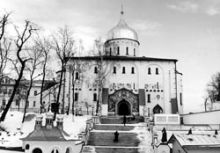Legend has it that long ago Ternopil was a town with swan-white structures protected with circular ramparts and motes, and a fortress that inspired fear into enemies and guarded the peace of her citizens. Merchants would bring expensive goods from all over the world and be struck with the residents’ hospitality. Unfortunately, the ideal did not last forever: one day black easterly clouds gathered over the town — a Tatar horde had come. In spite of desperate resistance, the white-stone town was utterly ruined, and those who had not fled were taken away into captivity. The devastated town was later overgrown with the tangled mass of briar whose flowers that ran riot in the spring seemed to bring back the former beauty of that settlement. When the remaining residents shook off the Tartar yoke at last, they put up a new town and named it Ternopil (“the city of briar”).
In all probability, this touching legend can be applied not only to the period that preceded the first “official” mentioning of Ternopil in written sources (in 1540, Polish King Zygmunt I gave a written permission to the Krakow magnate Jan Tarnawski to erect a fortress in Terebowla district). More than one generation of Ternopil dwellers saw their city devastated. It is not so important which of the strict arguments — “genetic memory” or different “mentality” of eastern and western Ukrainians — will explain better the reverent attitude of today’s Ternopil residents to their city. Nevertheless, the neatness of one of this country’s greenest cities (there are 63 square meters of greenery per citizen; by comparison, this figure is about 20 sq. m. in the major cities of Europe) is an indisputable fact. At any rate, this neatness coupled with the absence of mind-boggling and tasteless architectural combinations (for which Kyiv has been, unfortunately, notorious of late) made a favorable impression on guests from Kyiv who arrived in Ternopil to take part in a press tour and the regular Wind of Travels all-Ukrainian tourist film festival organized by the State Tourism Organization and the Ternopil oblast administration. This can be at least partially attributed to a close resemblance between the old areas of this city and those of the capital: one feels that the next narrow street will take him, for example, to Kyiv’s Yaroslaviv Val — and indeed, it does! Only the street has a different name in Ternopil, Russian Street.
Incidentally, the city’s beauty was also noted by one of the Johnson brothers whose cosmetics and household chemicals are well known in Ukraine. What is more, he noted this... without ever visiting the city. It turns out that Edward has two favorite hobbies: sculpturing and collecting postcards with the views of various cities. If he likes the view, he sends one of his sculptures to that city as a gift. So, after seeing Ternopil postcards, Edward made a sculpture for the city’s Theater Garden.
Seeing this unique piece should not be the only reason for touring Ternopil and its entire region, however. Before going there, this writer, as perhaps the majority of ordinary Ukrainians, naively believed that there is nothing in our homeland except the Carpathians and the Crimea to feast one’s eyes on. The bare facts say that it is a gross misconception: the rivers Zbruch, Dniester, Nichlava et al. have beautiful canyons suitable for trekking, one of the most popular activity holidays in the West. The region is also home to some of the world’s largest karstic caves, the main of which, Optimistic by name, is the longest (182 km) among gypsum caves, and second-longest among limestone caves on the globe. Ternopil oblast also hosts the Medobory Natural Preserve (to be discussed below), three regional landscape parks, 121 landscape, woodland, botanical, wildlife and hydrological sanctuaries, 3 botanical gardens, and this list could be continued. But even this is not all: the oblast’s main pride is its historical and cultural heritage, for more than three and a half thousand monuments and a third of all Ukraine’s castles are situated precisely here.
As you enter the oblast center, you can see a defensive castle on the bank of a large manmade lake. This structure was ruined several times — during a Turkish attack in 1675, and in the fires of the First and Second World Wars — and restored in the early 19th century and in 1951. Some distance away stands the Church of the Holy Cross Exaltation, built in the first half of the 16th century on the foundation of an ancient temple. In addition to this, there is a monumental Church of the Christ’s Nativity, the Church of the Holy Virgin’s Assumption rebuilt in 1991, and — undoubtedly the gem of the city — the majestic baroque-style (with some elements of rococo) Greek Catholic Cathedral of the Holy Virgin’s Immaculate Conception. Ternopil residents joke, “To each street a church of its own, to each church a bus stop of its own,” for there are about 43 religious communities in the oblast. Yet, at least at the cursory glance of a visitor, there is no discord at sight. We saw a tiny church being built a few paces away from another in a small town. “What can I do?” the local mayor sighs, “the Greek Catholics have a church of their own, while the Orthodox do not. Nor do we have any ‘free’ money, but still we must build one.”
DO TEMPLES HAVE TO FEAR THE WORD “SERVICE”?
Speaking of the places of worship, one should remember that the Ternopil oblast hosts two powerful religious centers — the Orthodox Golden Pochayiv Lavra (Monastery) in Kremenets and a Catholic temple in the village of Zarvanytsia. The golden domes of Pochayiv are in good view from afar and from any point: the Holy Virgin once appeared before the monks on the hill where the Lavra stands, leaving a footprint on the slope. Her appearance was sighted several times thereafter — when it was time to avert some danger from the land. Today, thousands of pilgrims, even from Siberia, come here to touch the salubrious footprint, the miraculous icon, and the relics of St. Job of Pochayiv. The iconostasis was given to the Lavra by Tsar Alexander II, while the mosaic pictures in the Holy Trinity Cathedral were made by Roerich.
Undoubtedly, there will be no decrease in the number of believers arriving at the Lavra in the decades to come. Yet, if the authorities paid more attention to tourism, this would be of undeniable befit, first of all, to the Lavra itself which could then function on a self-supporting basis. While pilgrims have a small hotel with a dining room at their disposal, lay tourists have to be content with just a few cafes and a dilapidated hotel. What the local bosses can offer now is only a plan of how to accommodate all the needy.
Things are slightly better at Zarvanytsia which the legend says was also blessed by the Holy Virgin and which also has a miraculous icon. It is planned to restore the whole temple complex around the existing Cathedral of the Holy Virgin of Zarvanytsia. The tireless Greek Catholics are, by all accounts, not afraid of the word “service.” They plan to build a high-class guest house, restore the Road of the Cross (the object of a heavy pilgrimage), and construct an underpass to the Cathedral. Thanks to the Greek Catholic clergy’s efforts, the village has now a wide Song Field, where festivities are held. Unfortunately, there are problems even here: villagers only know in theory what cooking gas is...
...For some time now, Zarvanytsia has had an unexpected “brother,” an old Scottish collie. It once came to the temple with a group of pilgrims and stayed behind. “We have driven him away a few times, but he always comes back,” the local priest says, smiling affectionately. Apparently, the Holy Spirit is not averse to descending even on quadrupeds. In any case, the Zarvanytsia pet’s wise eyes clearly say that it knows about this more than some bipeds do...
A PUZZLE CALLED BONA
The fortress on Bona Hill is the symbol of old Kremenets, whose foundation date still remains a matter of dispute. Some researchers claim the hill was thus named after Queen Bona, although the 1911 edition Encyclopedia asserts that the Kremenets fortress was built in the pre- Christian period approximately in the 8th-9th centuries, says Oksamyt-KL tourist agency guide Adelina Konchina. This is also proved by the legend about Irva, daughter of the Dulib tribe chief. The Tale of Bygone Years says that “...the Obres fought against the Slavs and... the Dulibs, also a Slav tribe, and raped Dulib women.” One day the Obres laid siege to the town on the hill where the fortress stands now but stopped short of storming it. The next day the Obre leader’s unarmed messengers knocked on the gate and said that if the Dulib chief gave his daughter in marriage to their leader, the Obres would leave the town intact and go away. The messengers gave Irva an extremely beautiful head scarf; but she tore it into pieces. “If a miracle occurs and the scarf knits together, then I will wed the Obres’ leader,” Irva said. A battle began at daybreak. The Dulib warriors — with Irva among them — fought fearlessly. The chief fell down, then the last daredevils were killed, and only Irva was still containing the enemies. In the end, Irva preferred death to captivity: she forced her way to a high cliff and jumped into the abyss. Today, a stream called Irva’s Tears runs under the hill and empties into the river Ikva. Yet, more than one cliff in the Ternopil oblast hillside bears a similar romantic legend about a girl who chose to die instead of marrying an enemy.
Kremenets was first mentioned in a 1064 Polish encyclopedic dictionary. Though, some Polish researchers like M. Belinski and T. Lipinski say there was no information about the Krtemenets castle in the source.
According to the guide, the Krements hill’s name can be associated with the famous Lithuanian clan of Gediminas, for the Galician-Volhynian Principality was taken over by the Grand Duchy of Lithuania in 1340. On April 4, 1536 Polish King and Grand Duke of Lithuania Zygmunt I the Elder, of the Gediminas dynasty, handed over the Kremenets castle and the nearby villages to his wife Bona who owned these until 1556.
Folk tales and legends depict Queen Bona as a treacherous and cruel woman. Historic Queen Bona was an Italian -born relative of the Holy Roman Emperor Maximillian I Habsburg and daughter of Milanese Duke Sforza. She ruled a clique of intriguants, and made a concentrated effort to help reinforce the Jagiellonian dynasty in Europe to the detriment of the Habsburgs and the Hohenzollerns. Striving to amass untold wealth for her dynasty, the queen used all means for attaining this goal. This also applied to the Kremenets land: heavy taxes were imposed on the local populace.
A folk legend has it that Queen Bona once ordered a leather bridge fixed over the castle mountain precipice. She liked walking on this bridge every day. One day the bridge collapsed, and while she was falling, she prayed passionately. Surviving by a miracle, she had a Catholic Franciscan cloister built at the foot of the castle mountain as a sign of gratitude. The cloister’s architectural complex includes cells adjacent to a Gothic-Renaissance-style church. In the mid-18th century, the church was enlarged by means of new naves and a narthex. The courtyard belfry (the 18th century) was redesigned in the baroque style by architect Pawel Gizicki. In 1832, the temple was given to the Orthodox Church and blessed as St. Nicholas’s Cathedral, which is still functioning under Moscow Patriarchate jurisdiction.
Still, Queen Bona is very unlikely to have ever visited Kremenets — in any case, there is no information to this effect in the Polish publications of those times. If the events described in the folk legend had indeed taken place, it would have happened in 1539: archival materials prove that the building of the temple began that year by the order of Queen Bona. Nevertheless, it is still a debatable point whether the queen had really anything to do with the hill crowned with the ruins of a castle. Whatever the case, the romantic legend undoubtedly adds charm to the already attractive sight to see.
(To be continued)







